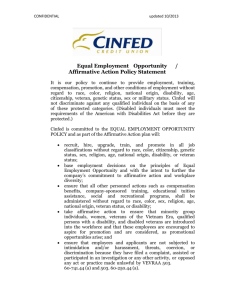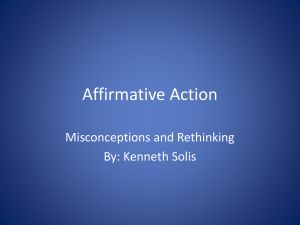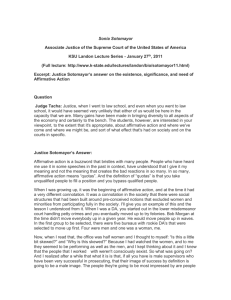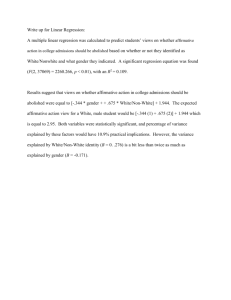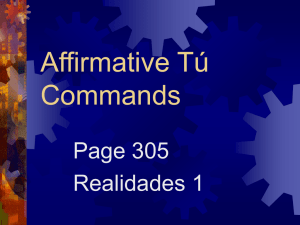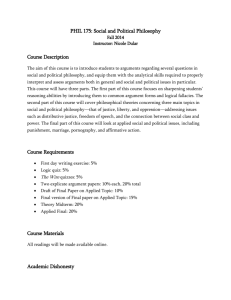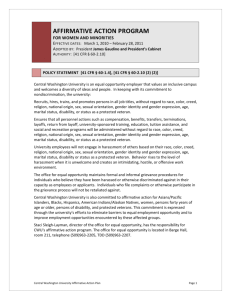10.001 - Affirmative Action Policy/EEO
advertisement
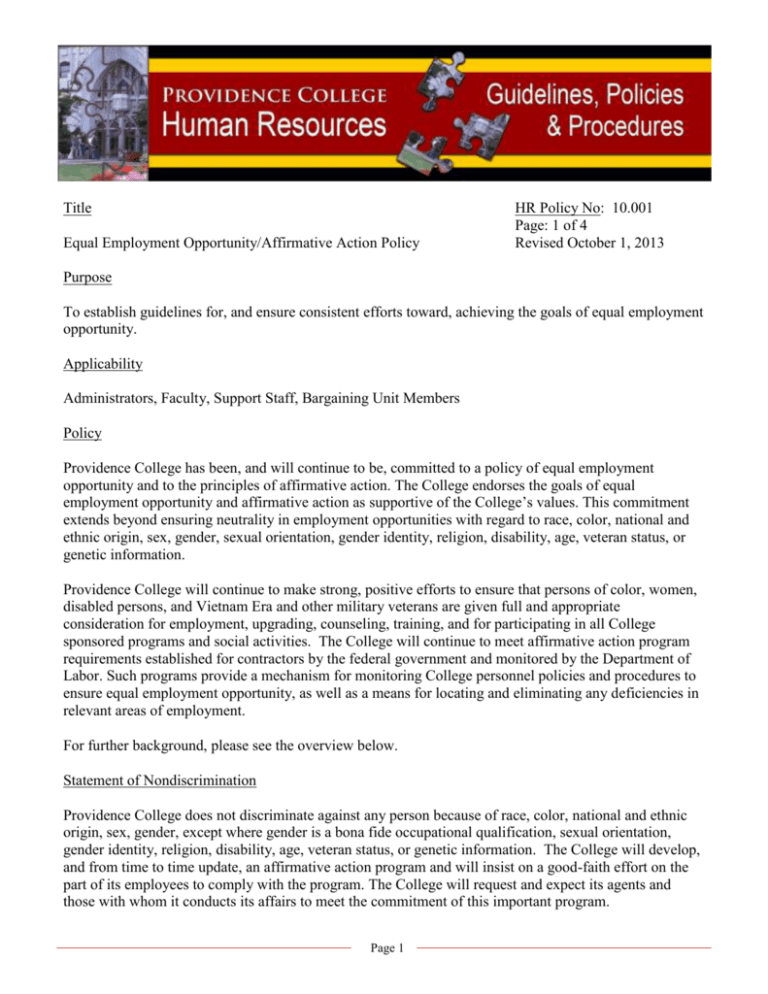
Title Equal Employment Opportunity/Affirmative Action Policy HR Policy No: 10.001 Page: 1 of 4 Revised October 1, 2013 Purpose To establish guidelines for, and ensure consistent efforts toward, achieving the goals of equal employment opportunity. Applicability Administrators, Faculty, Support Staff, Bargaining Unit Members Policy Providence College has been, and will continue to be, committed to a policy of equal employment opportunity and to the principles of affirmative action. The College endorses the goals of equal employment opportunity and affirmative action as supportive of the College’s values. This commitment extends beyond ensuring neutrality in employment opportunities with regard to race, color, national and ethnic origin, sex, gender, sexual orientation, gender identity, religion, disability, age, veteran status, or genetic information. Providence College will continue to make strong, positive efforts to ensure that persons of color, women, disabled persons, and Vietnam Era and other military veterans are given full and appropriate consideration for employment, upgrading, counseling, training, and for participating in all College sponsored programs and social activities. The College will continue to meet affirmative action program requirements established for contractors by the federal government and monitored by the Department of Labor. Such programs provide a mechanism for monitoring College personnel policies and procedures to ensure equal employment opportunity, as well as a means for locating and eliminating any deficiencies in relevant areas of employment. For further background, please see the overview below. Statement of Nondiscrimination Providence College does not discriminate against any person because of race, color, national and ethnic origin, sex, gender, except where gender is a bona fide occupational qualification, sexual orientation, gender identity, religion, disability, age, veteran status, or genetic information. The College will develop, and from time to time update, an affirmative action program and will insist on a good-faith effort on the part of its employees to comply with the program. The College will request and expect its agents and those with whom it conducts its affairs to meet the commitment of this important program. Page 1 Responsibility The associate vice president for human resources is responsible for the coordination and oversight of the College’s affirmative action employment programs and for monitoring the implementation of those programs throughout the College. ______________________________________________________________________________ Overview The following information has been prepared to introduce all employees of Providence College to the concepts of Equal Employment Opportunity and Affirmative Action, and, further, to explain the laws which govern these concepts and the procedures practiced by Providence College to ensure their implementation. Equal Employment Opportunity Equal Employment Opportunity is provided when all conditions of employment and management decisions are based on good, consistent, and fair human resource policy and procedure. Equal Opportunity in employment is an essential priority for Providence College, and one to which the College is deeply committed. In accordance with established federal laws (based in the Civil Rights Act of 1964), state laws, and College policies, discrimination based on race, color, national and ethnic origin, sex, gender, sexual orientation, gender identity, religion, disability, age, veteran status, or genetic information, is prohibited in all aspects of employment. Providence College is also committed to providing a work and academic environment free from all forms of sexual harassment. Affirmative Action Affirmative Action is a results-oriented program that is designed to redress imbalances of minorities and women in the workforce. Executive Order 11246 (1965), as amended by Executive Order 11375 (1967), as well as the Vietnam Era Veteran’s Readjustment Assistance Act of 1974 and Section 504 of the Rehabilitation Act of 1973, require federal contractors to take "affirmative" steps to recruit, hire and advance minorities and women when they are underutilized in the College and are qualified and available in the labor force. As part of the federal contract obligations, the College is required to determine whether women and minorities are "underutilized" in the workforce. When that is the case, the College is required to develop, as part of its affirmative action program, specific goals designed to overcome that underutilization. Underutilization is defined in the regulations as "having fewer women or minorities in a particular job group than would reasonably be expected by their availability." The College proactively undertakes good faith efforts to reach affirmative action goals through recruitment, outreach, and internal reviews of employment policies and practices. Affirmative Action goals are flexible, temporary, and aimed at correcting the imbalances. Goals are not quotas. Page 2 Diversity Diversity policies and programs at Providence College are designed to foster opportunities to embrace the greatest mix of ideas, opinions, and beliefs so important to the achievement of academic excellence. Accordingly, the term diversity, in its many forms, is used at the College in the broadest sense to encompass many things such as race, color, national and ethnic origin, sex, gender, sexual orientation, gender identity, religion, disability, age, veteran status, genetic information, language, socio-economic status and/or background, political ideology, theoretical approach, etc. Individuals with Disabilities A person with a disability is someone who: (1) has a physical or mental impairment that substantially limits one or more major life activities; (2) has a record of such impairment; or (3) is regarded as having such an impairment. A major life activity means a basic function such as working, caring for oneself, walking, seeing, hearing, breathing, etc. Employers are prohibited from discriminating against qualified individuals with disabilities in all terms, conditions, and privileges of employment. A qualified individual with a disability is a person who, with or without reasonable accommodation, can perform the essential functions of the job in question. Employers are required to make an accommodation to the known disability of a qualified applicant or employee if it would not impose an "undue hardship" on the operations of the employer's business. The employer is not required to lower quality or production standards to make an accommodation, nor is an employer obligated to provide items such as glasses or hearing aids. Disclosure of one's disability is strictly voluntary and will be kept confidential. Veterans Assistance Employers are prohibited from discriminating against veterans and are required to take affirmative action* to employ and advance in employment Vietnam Era and "Other Qualified" veterans and qualified disabled veterans of all wars. *The affirmative action requirements for qualified persons with disabilities and Vietnam Era, and other military, disabled veterans do not include goals and timetables in the same way that affirmative action programs establish such goals for women and minorities. Racial/Ethnicity People can self-identify in the following racial/ethnic categories: American Indian/Alaskan Native A person having origins in any of the original peoples of the present day United States (except Hawaii), and who maintains cultural identification through tribal affiliation or community recognition (includes the native peoples of Alaska). Page 3 Asian A person having origins in any of the original peoples of the Far East, Southeast Asia, or the Indian subcontinent, including, for example, Cambodia, China, India, Japan, Korea, Malaysia, Pakistan, the Philippine Islands, Thailand, and Vietnam. Native Hawaiian or Other Pacific Islander A person having origins in any of the peoples of Hawaii, Guam, Samoa, or other Pacific Islands. Black/African-American A person having origins in any of the black racial groups of Africa, not of Hispanic origin. Hispanic or Latino A person of Cuban, Mexican, Puerto Rican, South or Central American, or other Spanish culture or origin regardless of race. White (Not of Hispanic origin) a person having origins in any of the original peoples of Europe, North Africa, or the Middle East. Page 4
